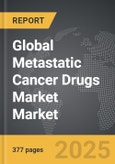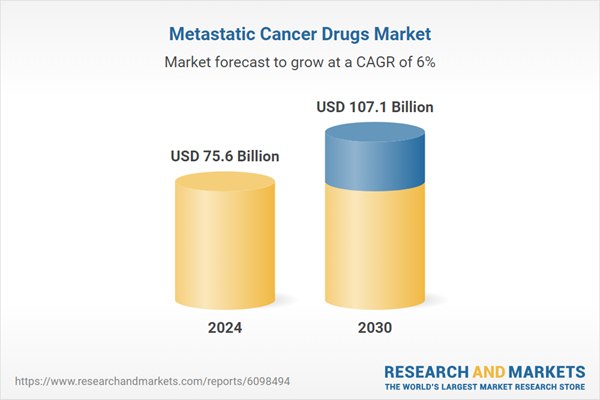Global Metastatic Cancer Drugs Market - Key Trends & Drivers Summarized
Why Does Metastatic Cancer Demand Distinct Therapeutic Strategies Beyond Conventional Oncology Protocols?
Metastatic cancer, the stage at which malignancy spreads beyond its primary origin to distant organs, represents the most advanced and life-threatening phase of cancer progression. It remains one of the most difficult oncology challenges, accounting for the majority of cancer-related mortalities worldwide. Unlike localized tumors, metastatic cancers exhibit complex genetic heterogeneity, resistance to standard therapies, and reduced responsiveness to localized treatments like surgery and radiation - necessitating specialized pharmacologic approaches.Treatment goals in metastatic settings often pivot from curative intent to prolonging survival, maintaining quality of life, and slowing disease progression. As such, drug development in this domain emphasizes cytostatic over cytotoxic effects, targeted inhibition of metastatic signaling pathways, and personalization based on molecular profiling. The growing recognition that metastasis represents a distinct biological state - rather than just a spatial extension - has spurred intensive research into its underlying mechanisms and therapeutics tailored for organ-specific metastases, such as brain, bone, or liver involvement.
How Are Targeted Therapies, Immuno-Oncology, and Genomic Innovations Reshaping the Drug Landscape?
The therapeutic landscape for metastatic cancer has evolved dramatically with the rise of targeted therapies, monoclonal antibodies, and immune checkpoint inhibitors. Drugs such as trastuzumab (HER2+ breast cancer), osimertinib (EGFR-mutant NSCLC), and enzalutamide (metastatic prostate cancer) exemplify how receptor-specific inhibition can extend survival in metastatic settings. These agents are designed to disrupt aberrant signaling cascades, inhibit angiogenesis, block hormone receptors, or interfere with metastatic cell migration and adhesion mechanisms.Immunotherapies, especially PD-1/PD-L1 inhibitors like pembrolizumab and nivolumab, are revolutionizing outcomes in melanoma, NSCLC, and renal cell carcinoma by enhancing endogenous immune recognition of tumor cells. CAR-T cell therapies and bispecific antibodies are also being explored in metastatic hematologic and solid tumors, targeting persistent clones that evade first-line treatments. Genomic sequencing platforms and liquid biopsies enable real-time tracking of tumor mutations, helping match patients to precision therapies or combination regimens that target multiple metastatic drivers simultaneously.
Which Cancer Types and Regional Markets Are Driving Clinical and Commercial Expansion of Metastatic Oncology Drugs?
Breast, lung, colorectal, prostate, and melanoma represent the most commercially significant cancer types in the metastatic drug market, each with substantial patient populations and differentiated treatment pipelines. For instance, HER2-positive and triple-negative breast cancer have distinct metastatic progression patterns and corresponding therapies. Non-small cell lung cancer (NSCLC) with brain metastases is a high-priority area for next-generation ALK and EGFR inhibitors. Similarly, metastatic colorectal cancer (mCRC) and hepatocellular carcinoma are increasingly treated with biologics targeting VEGF, EGFR, or multikinase pathways.North America and Europe remain the largest revenue-generating regions, supported by robust reimbursement structures, research infrastructure, and early access to FDA- and EMA-approved agents. However, Asia-Pacific markets - particularly China, Japan, and South Korea - are witnessing rapid growth due to increasing cancer prevalence, investments in biomarker-driven care, and the regional approval of biosimilars and homegrown immunotherapies. Latin America and the Middle East, though constrained by pricing and infrastructure gaps, are expanding access via public-private partnerships and cancer care reform initiatives.
What Is Driving Long-Term Growth and Innovation in the Metastatic Cancer Drug Market?
The growth in the metastatic cancer drugs market is being driven by rising cancer incidence, expanded molecular diagnostics, and strategic repositioning of novel therapeutics into late-stage treatment algorithms. Breakthroughs in cancer immunology, epigenetics, and tumor microenvironment modulation are expanding the scope of druggable targets. Companion diagnostics and biomarker-guided therapy selection are enabling better stratification of patients, improving response rates and minimizing trial-and-error in late-stage treatment.Pharmaceutical pipelines are increasingly focused on combination regimens, sequencing strategies, and novel mechanisms such as antibody-drug conjugates (ADCs), PARP inhibitors, and tumor-agnostic therapies. Additionally, payer support for life-extending therapies in metastatic settings is enabling broader market access. Real-world evidence (RWE), value-based pricing models, and regulatory frameworks like accelerated approval and breakthrough therapy designation are further accelerating commercialization.
As metastatic cancer care moves toward increasingly individualized, biologically informed treatment regimens, the market for drugs addressing this high-mortality segment will continue to expand - underscoring the convergence of precision oncology, immune modulation, and translational research as core pillars of therapeutic advancement.
Report Scope
The report analyzes the Metastatic Cancer Drugs market, presented in terms of market value (US$). The analysis covers the key segments and geographic regions outlined below:- Segments: Therapy (Chemotherapy, Hormonal Therapy, Targeted Therapy, Immunotherapy); Indication (Breast Cancer, Lung Cancer, Prostate Cancer, Colorectal Cancer, Melanoma, Other Indications); Distribution Channel (Hospital Pharmacies, Drug Stores & Retail Pharmacies, Online Providers).
- Geographic Regions/Countries: World; United States; Canada; Japan; China; Europe (France; Germany; Italy; United Kingdom; Spain; Russia; and Rest of Europe); Asia-Pacific (Australia; India; South Korea; and Rest of Asia-Pacific); Latin America (Argentina; Brazil; Mexico; and Rest of Latin America); Middle East (Iran; Israel; Saudi Arabia; United Arab Emirates; and Rest of Middle East); and Africa.
Key Insights:
- Market Growth: Understand the significant growth trajectory of the Chemotherapy segment, which is expected to reach US$57.8 Billion by 2030 with a CAGR of a 7.2%. The Hormonal Therapy segment is also set to grow at 4.2% CAGR over the analysis period.
- Regional Analysis: Gain insights into the U.S. market, valued at $20.6 Billion in 2024, and China, forecasted to grow at an impressive 9.6% CAGR to reach $22.1 Billion by 2030. Discover growth trends in other key regions, including Japan, Canada, Germany, and the Asia-Pacific.
Why You Should Buy This Report:
- Detailed Market Analysis: Access a thorough analysis of the Global Metastatic Cancer Drugs Market, covering all major geographic regions and market segments.
- Competitive Insights: Get an overview of the competitive landscape, including the market presence of major players across different geographies.
- Future Trends and Drivers: Understand the key trends and drivers shaping the future of the Global Metastatic Cancer Drugs Market.
- Actionable Insights: Benefit from actionable insights that can help you identify new revenue opportunities and make strategic business decisions.
Key Questions Answered:
- How is the Global Metastatic Cancer Drugs Market expected to evolve by 2030?
- What are the main drivers and restraints affecting the market?
- Which market segments will grow the most over the forecast period?
- How will market shares for different regions and segments change by 2030?
- Who are the leading players in the market, and what are their prospects?
Report Features:
- Comprehensive Market Data: Independent analysis of annual sales and market forecasts in US$ Million from 2024 to 2030.
- In-Depth Regional Analysis: Detailed insights into key markets, including the U.S., China, Japan, Canada, Europe, Asia-Pacific, Latin America, Middle East, and Africa.
- Company Profiles: Coverage of players such as Akemi GmbH, Araldite (Huntsman Corp.), Devcon (ITW Performance Polymers), Fastfix-it, Hypoxy Systems Inc. and more.
- Complimentary Updates: Receive free report updates for one year to keep you informed of the latest market developments.
Some of the 32 companies featured in this Metastatic Cancer Drugs market report include:
- AbbVie Inc.
- Amgen Inc.
- Astellas Pharma Inc.
- AstraZeneca PLC
- Bayer AG
- Biogen Inc.
- Bristol-Myers Squibb Company
- Celgene Corporation
- Eli Lilly and Company
- F. Hoffmann-La Roche Ltd.
- GlaxoSmithKline plc
- Ipsen
- Johnson & Johnson
- Merck & Co., Inc.
- Novartis AG
- Pfizer Inc.
- Regeneron Pharmaceuticals Inc.
- Sanofi S.A.
- Seagen Inc.
- Takeda Pharmaceutical Company
This edition integrates the latest global trade and economic shifts into comprehensive market analysis. Key updates include:
- Tariff and Trade Impact: Insights into global tariff negotiations across 180+ countries, with analysis of supply chain turbulence, sourcing disruptions, and geographic realignment. Special focus on 2025 as a pivotal year for trade tensions, including updated perspectives on the Trump-era tariffs.
- Adjusted Forecasts and Analytics: Revised global and regional market forecasts through 2030, incorporating tariff effects, economic uncertainty, and structural changes in globalization. Includes historical analysis from 2015 to 2023.
- Strategic Market Dynamics: Evaluation of revised market prospects, regional outlooks, and key economic indicators such as population and urbanization trends.
- Innovation & Technology Trends: Latest developments in product and process innovation, emerging technologies, and key industry drivers shaping the competitive landscape.
- Competitive Intelligence: Updated global market share estimates for 2025, competitive positioning of major players (Strong/Active/Niche/Trivial), and refined focus on leading global brands and core players.
- Expert Insight & Commentary: Strategic analysis from economists, trade experts, and domain specialists to contextualize market shifts and identify emerging opportunities.
Table of Contents
Companies Mentioned (Partial List)
A selection of companies mentioned in this report includes, but is not limited to:
- AbbVie Inc.
- Amgen Inc.
- Astellas Pharma Inc.
- AstraZeneca PLC
- Bayer AG
- Biogen Inc.
- Bristol-Myers Squibb Company
- Celgene Corporation
- Eli Lilly and Company
- F. Hoffmann-La Roche Ltd.
- GlaxoSmithKline plc
- Ipsen
- Johnson & Johnson
- Merck & Co., Inc.
- Novartis AG
- Pfizer Inc.
- Regeneron Pharmaceuticals Inc.
- Sanofi S.A.
- Seagen Inc.
- Takeda Pharmaceutical Company
Table Information
| Report Attribute | Details |
|---|---|
| No. of Pages | 377 |
| Published | December 2025 |
| Forecast Period | 2024 - 2030 |
| Estimated Market Value ( USD | $ 75.6 Billion |
| Forecasted Market Value ( USD | $ 107.1 Billion |
| Compound Annual Growth Rate | 6.0% |
| Regions Covered | Global |









